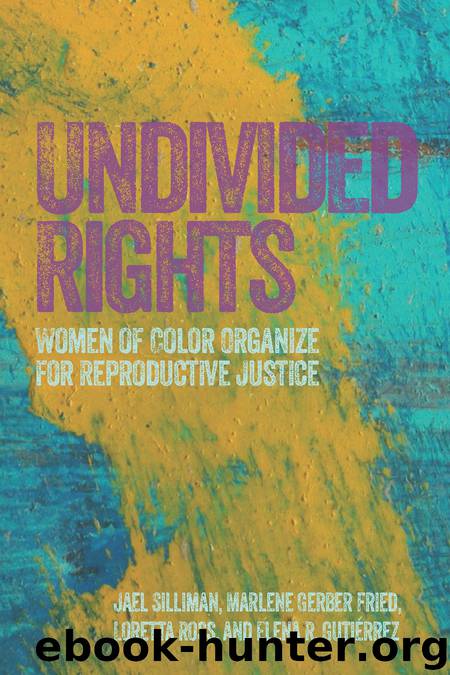Undivided Rights by Loretta Ross

Author:Loretta Ross
Language: eng
Format: epub
Tags: Women's Studies, ebook
ISBN: 978-1-60846-664-1
Publisher: Haymarket Books
Published: 2016-04-03T16:00:00+00:00
* * *
NOTES
1 Shamita Das Dasgupta talks about the importance of “becoming reacquainted with our own heroines” as a key aspect of activist history in her introduction to A Patchwork Shawl: Chronicles of South Asian Women in America (New Brunswick, NJ: Rutgers University Press, 1998), 12. Echoing the same idea, Yuri Kochiyama tells about Queen Liliuokalani, a native Hawaiian who called her people to action after she was dethroned by US military action in 1893 in the preface to Dragon Ladies: Asian American Feminists Breath Fire, ed. Sonia Shah (Boston: South End Press, 1997).
2 Dasgupta, A Patchwork Shawl, 10.
3 API includes people from many countries in the East Asia, Southeast Asia, South Asia, and the Pacific Islands.
4 Both women were early board members of the National Asian Women’s Health Organization.
5 Sia Nowrojee and Jael Silliman, “Asian Women’s Health: Organizing a Movement,” in Dragon Ladies, 84.
6 Pamela Chiang et al., “On Asian America, Feminism, and Agenda-Making: A Roundtable Discussion,” in Dragon Ladies, 58.
7 In addition to the Chinese Exclusion Act of 1882, other restrictions included the Act to Prevent the Kidnapping and Importation of Mongolian, Chinese, and Japanese Females for Criminal and Demoralizing Purposes (1879); the Gentleman’s Agreement capped Japanese and Korean immigration (1907); The Immigration Act of 1917 curbed Asian Indian immigration; the Oriental Exclusion Act of 1924 stopped labor immigration from mainland Asia; and the Tydings-McDuffie Act restricted Filipino immigration (1934). Citizenship through naturalization was denied to all Asians between 1924 and 1943. The pattern here was to welcome Asians when their labor was needed and to exclude them when the economy stagnated. Sucheta Mazumdar discusses this in “General Introduction: A Woman-Centered Perspective on Asian American History,” in Making Waves: An Anthology of Writings by and about Asian American Women, ed. Asian Women United of California (Boston: Beacon Press, 1989), 1–3.
8 Mazumdar, “General Introduction,” 1.
9 The law suspended Chinese labor immigration and excluded all Chinese, other than merchants, students, diplomats, and visitors, from immigrating to the United States. Other restrictive legislation followed.
10 Lora Jo Foo, Asian American Women: Issues, Concerns, and Responsive Human and Civil Rights Advocacy, Ford Foundation Report (New York: Ford Foundation Report, 2002), 13.
11 Mazumdar, “General Introduction,” 2.
12 Shah, Dragon Ladies, xiv.
13 Karen Isaksen Leonard, Making Ethnic Choices: California’s Punjabi Mexican Americans (Philadelphia: Temple University Press, 1992), chapter 2.
14 Sonia Shah, “Three Hot Meals and a Full Day at Work: South Asian Women’s Labor in the United States,” in A Patchwork Shawl, 214.
15 Sucheng Chan, “The Exclusion of Chinese Women, 1870–1943” in Entry Denied: Exclusion and the Chinese Community in America, 1882–1943, ed. Sucheng Chan (Philadelphia: Temple University Press, 1991), 97–99, 138 quoted in Shah, Dragon Ladies, xiv.
16 Connie Yung Yu, “The World of Our Grandmothers,” in Making Waves, 35.
17 Ibid.
18 Anannya Bhattacharjee, “The Habit of Ex-nomination: Nation, Woman, and the Indian Immigrant Bourgeoisie,” in A Patchwork Shawl, 177.
19 Foo, Asian American Women, 13.
20 NAWHO, Learning From Communities: A Guide to Addressing the Reproductive Health Needs of Vietnamese American Women, April 1998, 7.
21 Foo, Asian American Women, 14.
Download
This site does not store any files on its server. We only index and link to content provided by other sites. Please contact the content providers to delete copyright contents if any and email us, we'll remove relevant links or contents immediately.
| African-American Studies | Asian American Studies |
| Disabled | Ethnic Studies |
| Hispanic American Studies | LGBT |
| Minority Studies | Native American Studies |
Cecilia; Or, Memoirs of an Heiress — Volume 1 by Fanny Burney(32434)
Cecilia; Or, Memoirs of an Heiress — Volume 2 by Fanny Burney(31869)
Cecilia; Or, Memoirs of an Heiress — Volume 3 by Fanny Burney(31852)
The Great Music City by Andrea Baker(31340)
We're Going to Need More Wine by Gabrielle Union(18967)
All the Missing Girls by Megan Miranda(15565)
Pimp by Iceberg Slim(14393)
Bombshells: Glamour Girls of a Lifetime by Sullivan Steve(13972)
Talking to Strangers by Malcolm Gladwell(13222)
Norse Mythology by Gaiman Neil(13204)
Fifty Shades Freed by E L James(13157)
For the Love of Europe by Rick Steves(12946)
Mindhunter: Inside the FBI's Elite Serial Crime Unit by John E. Douglas & Mark Olshaker(9200)
Crazy Rich Asians by Kevin Kwan(9167)
The Lost Art of Listening by Michael P. Nichols(7406)
Enlightenment Now: The Case for Reason, Science, Humanism, and Progress by Steven Pinker(7228)
The Four Agreements by Don Miguel Ruiz(6630)
Bad Blood by John Carreyrou(6552)
Weapons of Math Destruction by Cathy O'Neil(6142)
